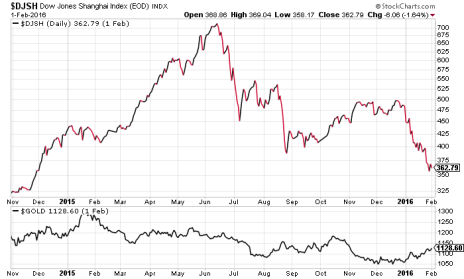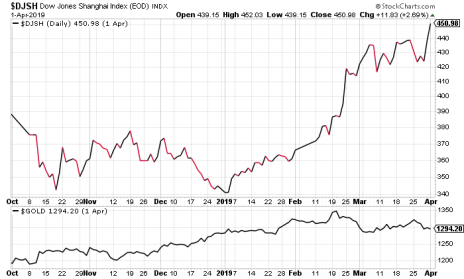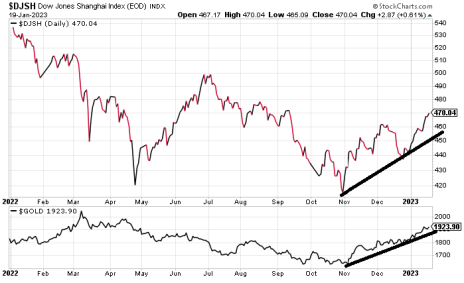China’s stock market has launched an impressive turnaround, thanks largely to an anticipated rebound in economic activity. Those expectations are based on Beijing’s recent reversal of its strict Covid policies and, as I’ll explain here, the newfound optimism carries great significance for investors in both Chinese stocks and gold.
While not widely known, there’s a fairly close historical correlation between China’s stock market trend and the gold price trend. Specifically, when China stocks are in the ascendant, gold prices tend to follow the same upward path. Conversely, a bear market in China’s equity market typically sees gold prices slumping.
It should be emphasized that the relationship between China’s stock market—as reflected in the Shanghai Composite Index—and gold isn’t always a perfect one-to-one correlation. And it’s useful to know that sometimes gold prices lead China’s market higher (or lower) while at other times China stocks are in the leadership position.
The takeaway here isn’t that one market always leads the other, but that both markets tend to confirm the main trend of the other. In cases where one market moves strongly higher while the other declines, it’s a sign the rising market’s trend (whether gold or stocks) is unsustainable and will likely soon reverse. (Think of the China stock/gold relationship as being something like Dow Theory, which posits that the Dow Jones Transportation Average should ideally confirm rising trends in the Dow Industrials to ensure a healthy market.)
One reason for the connection between gold and China stocks is that China is the world’s top gold consumer. Along with India, China accounts for nearly 60% of gold jewelry consumption globally. China is also the world’s top gold producer and is responsible for some 11% of production worldwide.
[text_ad]
China’s citizens, moreover, have long had an affinity for gold with many of them keeping a portion of their life savings in the form of physical bullion, jewelry or gold coins. China’s love for the yellow metal helps explain why gold’s price trends are largely influenced by China’s economy. Simply put, when China’s consumers are in a position of strength, they buy gold—and lots of it; on the other hand, gold demand tends to diminish when China’s economy is weakening.
With this in mind, let’s take a look at some examples from the recent past as to how this relationship works and, more importantly, how you can use it to profit from trends in both markets. (In the examples below I’ll be using the Dow Jones Shanghai Index to represent China’s stock market trends, with gold prices on the lower part of each chart.)
Gold Prices and Chinese Stocks
Shown here is the last runaway bull market China’s equity market experienced in the last decade. It began in late 2014 and peaked the following June. Gold prices, however, refused to confirm the runaway rally in China stocks (which later proved to be more of a “bubble” than a fundamentals-based bull market). The stock rally proved to be relatively short-lived and eventually, stocks succumbed to selling pressure. The bearish gold trend during those months warned astute investors to not believe the hype.
On the other side of the ledger, while both gold and Chinese stocks were on the rise during the years 2009 through 2010 (not shown), gold prices continued to rally into September 2011 while Chinese equities trended lower for most of that year. As it turned out, this divergence was something of a warning sign for gold investors, as the metal ended up collapsing in late 2011 and following China stocks lower for the next two years.
A more recent example of gold serving as a “heads up” for China’s stock market happened in the fourth quarter of 2018 when the metal’s price commenced a sudden ascent that continued well into 2020. In this case, gold prices led the way higher for China stocks with a lag time of about two months. But the message was unmistakable: global gold demand was exploding in the face of China’s trade war with the U.S., which hurt the latter more than the former. And as the market evidently foresaw a beneficial outcome to the trade war for China, Chinese stocks kicked off a bull market well in advance of the trade deal that was signed in early 2020.
Fast-forward to 2022 when China’s zero-Covid policy was in full swing and it’s clear to see the detrimental impact it had on both the nation’s economy and equity market. Starting last fall, however, when it became apparent the government would loosen the strictures, both gold and stocks turned the corner at the same time. For the last three months, both markets have trended higher in unison—the first such occurrence over a similar timeframe since 2020.
The implication of this relationship is bullish for both markets. And while the duration of the upward trend is anyone’s guess, similar occurrences in the past have resulted in elevated prices for both markets lasting anywhere from five to 18 months. All told, if the historical relationship holds true this time around, China and gold investors can expect better times as we head further into the new year.
[author_ad]




